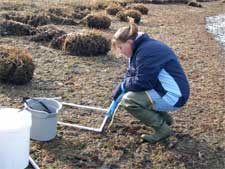 East Haddam, Conn., resident to report results at July 29 conference
East Haddam, Conn., resident to report results at July 29 conference
KINGSTON, R.I. – July 27, 2011 – Two species of seaweed are primarily responsible for most of the harmful algae blooms that occur in Narragansett Bay and other nearby waters, but they are so closely related that scientists are unsure how they can even survive together. This summer a University of Rhode Island student is seeking insights into how they compete with each other in hopes of identifying how to mitigate their growth.
Shelby Rinehart, a junior from East Haddam, Conn., studying biological sciences at URI, said that the two species are collectively called sea lettuce but are individually called Ulva rigida and Ulva compressa.
“We know they occur in about equal quantities at our sites in Greenwich Bay, and they look almost identical,” she said. “We want to see how they can co-exist in an ecosystem where you would assume they have the same niche and serve the same ecological purpose.”
In collaboration with URI Associate Professor Carol Thornber and graduate student Michele Guidone, Rinehart set up two experiments – one in a laboratory setting and another at Oakland Beach in Warwick – to determine how the species interact under various conditions.
“We assumed that the two species are overlapping in the nutrients they consume and the space they need to live, and that competition could result in reduced growth rates or even death,” Rinehart said. “But what we learned was somewhat surprising.”
The researchers found that Ulva compressa grows substantially faster than Ulva rigida, and it competes with itself for resources under shady conditions but competes with U. rigida when the sun is out. In addition, because Ulva rigida grows so much more slowly, it is also competing more with U. compressa for resources than with others of its own kind.
Rinehart said that another factor affecting the size and composition of algae blooms is herbivory. Snails, crabs and amphopods feed on U. compressa, but U. rigida has chemical defenses that make it an undesirable food source.
“So compressa grows quickly but is limited by the number of other compressas in the area, and it is also kept in check by the snails and crabs. Rigida, on the other hand, grows slowly, isn’t eaten by anything, and doesn’t compete with itself,” Rinehart said. “Overall, compressa is the superior competitor, but when herbivores are present, rigida can gain a competitive advantage.”
Rinehart’s research was made possible by the federally funded Experimental Program to Stimulate Competitive Research (EPSCoR), a program of the National Science Foundation. She will report the results of her research on July 29 at the Ryan Center at the Rhode Island Summer Undergraduate Research Fellows conference, along with more than 100 other students from throughout Rhode Island. The conference is a collaborative program of EPSCoR and the Rhode Island IDEA Network of Biomedical Research Excellence, both of which place undergraduates in hands-on research experiences in laboratories throughout the state.
The next step in learning about the ecology of algae blooms will find Rinehart working to identify the different nutrients that each species of algae consume.
“It’s been a strange summer,” she admits. “At first it was hard to find any rigida, and now we can’t find any compressa. There is a normal switching from one to the other in the summer, but it’s not usually this dramatic a change.”
Which could open up another line of inquiry for the next stage of Rinehart’s research.
Pictured above
URI student Shelby Rinehart studies seaweed at Oakland Beach in Warwick.

